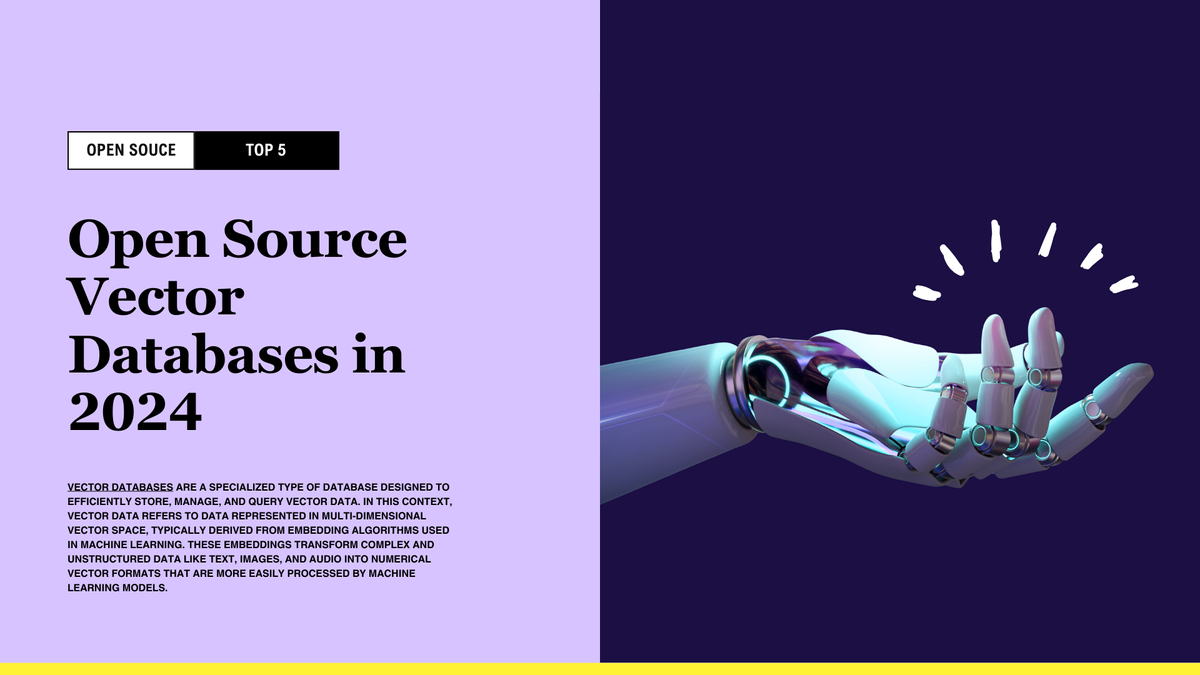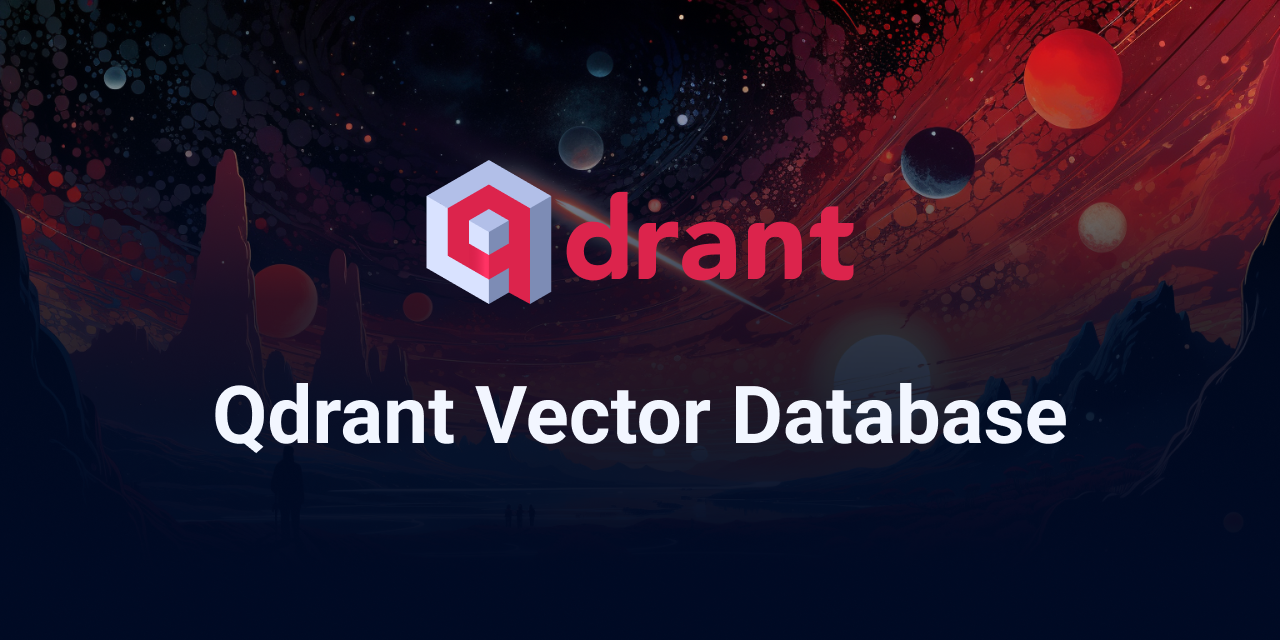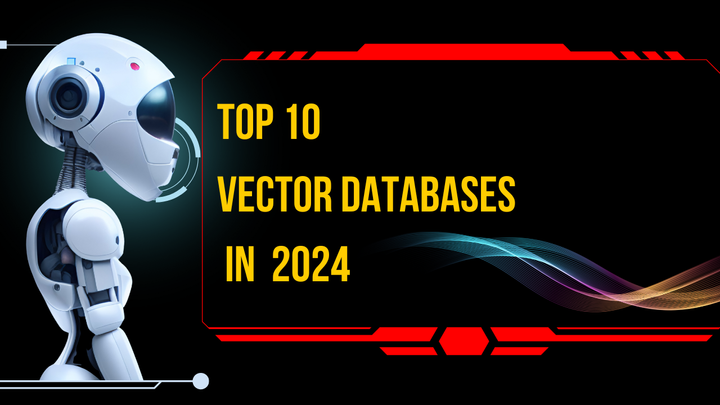Top 5 Open Source Vector Databases in 2024

Vector databases are a specialized type of database designed to efficiently store, manage, and query vector data. In this context, vector data refers to data represented in multi-dimensional vector space, typically derived from embedding algorithms used in machine learning. These embeddings transform complex and unstructured data like text, images, and audio into numerical vector formats that are more easily processed by machine learning models.
Benefits of Vector Databases
- Efficient Data Management: Vector databases excel in handling massive volumes of unstructured data such as text, images, and audio files, making them ideal for businesses dealing with large datasets.
- Enhanced Search Capabilities: These databases are known for their advanced search features, particularly in similarity searches, which are essential for applications like recommendation systems and natural language processing.
- Scalability: Vector databases are designed to scale with growing data and computational needs, ensuring they can adapt to dynamic business environments.
- Compatibility with AI and Machine Learning: The integration of vector databases with AI and machine learning models enhances data analysis and decision-making processes, offering more sophisticated applications.
Top 5 Vector Database
The world of artificial intelligence (AI) is rapidly evolving, and at the forefront of this progress lies a new breed of database: vector databases. But with numerous options available, choosing the right one can be overwhelming. This blog post dives into five leading contenders in the vector database arena: Chroma DB, Weaviate, Qdrant, Milvus, and Faiss. We'll unveil their strengths, explore their functionalities, and help you navigate the exciting world of AI-powered data retrieval.
- Chroma DB: The Open-Source Champion for Language Embeddings
Chroma DB stands out as a free and open-source vector database specifically designed for large language models (LLMs). Imagine a vast library of text data, each entry meticulously transformed into a unique fingerprint. Chroma DB excels at navigating this library, allowing researchers and developers to search and filter through these "language embeddings" with unmatched ease.
- Weaviate: The All-rounder for Diverse Machine Learning Models

Weaviate takes a unique approach, acting as a one-stop shop for both your data and its AI-generated representations. It seamlessly stores not only raw data objects but also the vector embeddings derived from various machine learning models. This versatility, coupled with its lightning-fast search capabilities, empowers users to explore complex datasets and uncover hidden patterns at unprecedented speed.
- Qdrant: The Champion for Efficient Similarity Search and Geo Data Management

Qdrant emerges as a powerful open-source vector database specifically designed for efficient similarity search and location-based data management. Imagine a vast library of high-dimensional vectors, each representing an image, document, user location, or any other data point with spatial characteristics.
- Milvus: The Robust Platform for High-Performance Needs

Milvus caters to the demanding needs of modern data-driven enterprises. This robust platform offers exceptional performance and scalability, perfectly suited for storing, retrieving, and analyzing massive volumes of high-dimensional vector data. Milvus leverages advanced algorithms and distributed computing to empower organizations to unlock valuable insights and drive transformative innovation.
- Faiss: The Facebook AI Powerhouse for Research and Development

Developed by the renowned Facebook AI team, Faiss is a cornerstone tool in the vector database landscape. Its meticulous engineering prioritizes lightning-fast similarity search and robust clustering operations. Whether you're a researcher, developer, or deploying applications in production, Faiss empowers efficient exploration and extraction of insights from even the most vast datasets.
Choosing Your AI-powered Vector Database Champion
The ideal vector database for you depends on your specific needs. Consider factors like the type of data you'll be working with, the scale of your operations, and the level of technical expertise required. The table below provides a quick comparison of some key features to aid your decision-making process:
Head-to-Head Comparison of Vector Databases
| Feature | Chroma DB | Weaviate | Qdrant | Milvus | Faiss |
|---|---|---|---|---|---|
| Open-Source | Yes | Yes | Yes | Yes | Yes |
| Primary Focus | LLM Embeddings | All Data & Embeddings | Location-based data & queries | High-Performance | Similarity Search & Clustering |
Overall, the top 5 open-source vector databases mentioned above provide a glimpse into the diverse and innovative solutions available for businesses seeking scalable AI solutions. By leveraging the unique features and capabilities of these databases, organizations can enhance their data management and processing capabilities significantly.
Key Features of Vector Databases
Vector databases offer a unique set of features that set them apart from traditional databases, especially when it comes to handling complex and unstructured data efficiently. Let's delve into some of the key features that make open-source vector databases a strategic choice for businesses:
Efficient Data Management
- Scalability: Vector databases are designed to scale seamlessly with the increasing volume of data, making them ideal for businesses dealing with large datasets. This scalability ensures that the database can adapt to dynamic business environments without compromising on performance.
- Advanced Search Capabilities: One of the standout features of vector databases is their ability to perform advanced searches, especially in similarity searches. This feature is crucial for applications like recommendation systems and natural language processing, enhancing the overall user experience.
Enhanced Integration with AI and Machine Learning
- Compatibility: Vector databases seamlessly integrate with AI and machine learning models, enhancing data analysis and decision-making processes. This integration allows for more sophisticated applications that leverage the power of AI technologies.
- Real-time Processing: The real-time processing capabilities of vector databases are invaluable, particularly in scenarios like fraud detection or real-time personalization strategies. This feature enables businesses to make quick, data-driven decisions in response to real-time insights.
Final Thoughts
As we conclude our exploration of the world of open-source vector databases, it becomes evident that these innovative solutions play a pivotal role in reshaping data management and processing capabilities for businesses across various industries. The unique features and capabilities offered by open-source vector databases make them a strategic choice for organizations looking to leverage the full potential of their data assets in the era of AI and big data.
Exploring the top 5 open-source vector databases, including Chroma DB, Weaviate, Qdrant, Milvus, and Faiss, showcases the diverse range of options available to businesses seeking scalable AI solutions. Each of these databases offers unique features and capabilities tailored to address specific data management needs, making them valuable assets for organizations looking to stay ahead in the rapidly evolving landscape of data technology.
Overall, open-source vector databases have revolutionized the way businesses approach data management and processing, offering innovative solutions that empower organizations to unlock new possibilities and drive growth in the digital age. By embracing these cutting-edge technologies, businesses can transform their data management and processing capabilities, paving the way for a more efficient and data-driven future.
FAQ's
1. Which vector database is open-source?
Several open-source vector databases are available, including:
- Milvus Open source vector database.
- Faiss (Facebook AI Similarity Search) Faiss: A library for efficient similarity search
- Vespa: vespa open source(offers vector functionalities)
2. What's the best vector database?
There's no single "best" vector database. The best choice depends on your specific needs. Consider factors like:
- Scalability: How much data do you need to store and query?
- Performance: How fast do you need similarity searches to be?
- Features: Does the database offer the specific features you need (e.g., k-nearest neighbors search)?
- Ease of use: How easy is it to set up and use the database?
3. Is Pinecone vector DB open-source?
No, Pinecone is a commercial vector database service.
4. What are vectors in databases?
In vector databases, data is stored as mathematical representations called vectors. These vectors are multi-dimensional arrays that capture the essential characteristics of a data point. The number of dimensions can vary depending on the complexity of the data.
5. Is MongoDB a vector database?
No, MongoDB is a general-purpose NoSQL database that doesn't specialize in vector data storage or similarity search.
6. Is Postgres a vector database?
Similar to MongoDB, Postgres is a relational database not specifically designed for vector data. While extensions can add some vector functionalities, it's not ideal for large-scale vector workloads.
7. Which vector database is best for LLMs (Large Language Models)?
There isn't a single best choice, but some factors to consider include:
- Scalability to handle the massive amount of data LLMs process.
- Performance for efficient retrieval of similar data points during training and inference.
- Integration with LLM frameworks for seamless workflow.
Popular options for LLMs include Milvus, Faiss, and Pinecone (commercial).
8. Do LLMs use vector databases?
Yes, LLMs can leverage vector databases in several ways:
- Training data retrieval: Finding similar training examples can accelerate the learning process.
- Inference: Vector databases can help retrieve relevant data points for generating text, translating languages, or completing other LLM tasks.
9. What type of database do LLMs use?
While LLMs can utilize traditional databases for storing raw text data, vector databases play a crucial role in managing the high-dimensional vector representations used during training and inference.
10. Some examples of vector databases?








